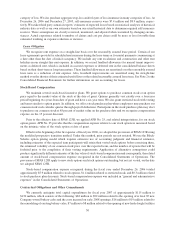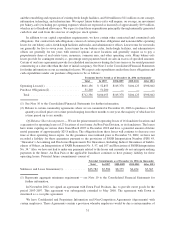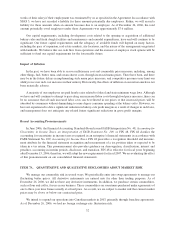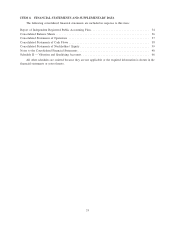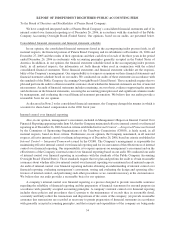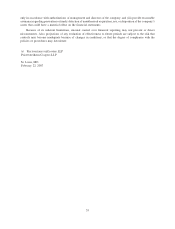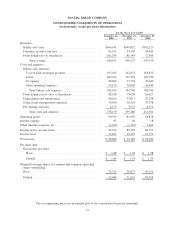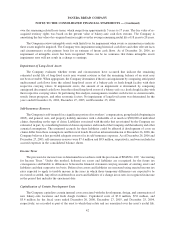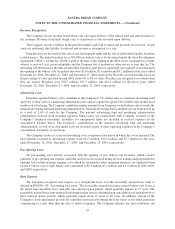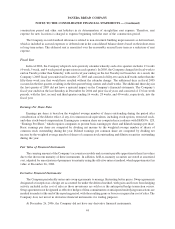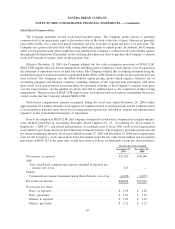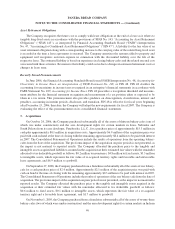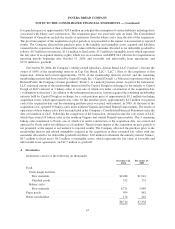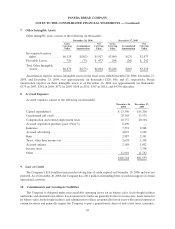Panera Bread 2006 Annual Report Download - page 45
Download and view the complete annual report
Please find page 45 of the 2006 Panera Bread annual report below. You can navigate through the pages in the report by either clicking on the pages listed below, or by using the keyword search tool below to find specific information within the annual report.PANERA BREAD COMPANY
NOTES TO THE CONSOLIDATED FINANCIAL STATEMENTS
1. Nature of Business
Panera Bread Company operates a retail bakery-cafe business and franchising business under the concept
names Panera Bread»and Saint Louis Bread Co.»As of December 26, 2006, the Company’s retail operations
consist of 391 Company-owned bakery-cafes. The Company specializes in meeting consumer dining needs by
providing high quality food, including fresh baked goods, made-to-order sandwiches on freshly baked breads,
Crispani»hand-crafted pizza, soups, salads, and cafe beverages, and targets suburban dwellers and workers by
offering a premium specialty bakery and cafe experience with a neighborhood emphasis. Bakery-cafes are
principally located in suburban, strip mall, and regional mall locations and currently operate in 38 states.
Bakery-cafes use fresh dough for their artisan and sourdough breads and bagels. As of December 26, 2006, the
Company’s fresh dough operations, which supply fresh dough items daily to both Company-owned and franchise-
operated bakery-cafes, consisted of 18 Company-owned fresh dough facilities.
2. Summary of Significant Accounting Policies
Basis of Presentation and Principles of Consolidation
The consolidated financial statements consist of the accounts of Panera Bread Company and its wholly owned
and indirect consolidated subsidiaries. All intercompany balances and transactions have been eliminated in
consolidation.
Certain reclassifications have been made to conform previously reported data to the current presentation.
Preparation of Financial Statements
The preparation of financial statements in conformity with accounting principles generally accepted in the
United States of America requires management to make estimates and assumptions that affect the reported amounts
of assets and liabilities and disclosure of contingent assets and liabilities at the date of the financial statements and
the reported amounts of revenues and expenses during the reporting period. Actual results could differ from those
estimates.
Cash and Cash Equivalents
The Company considers all highly liquid investments with a maturity at the time of purchase of three months or
less to be cash equivalents.
Investments in Government Securities
Investments of $20.0 million and $46.3 million at December 26, 2006 and December 27, 2005, respectively,
consist of United States treasury notes and government agency securities. During 2006, $57.2 million of invest-
ments matured or were called by the issuer and $30.6 million of investments were purchased by the Company.
During 2005, $2.0 million of investments matured or were called by the issuer and $20.0 million of investments
were purchased by the Company. During fiscal years 2006, 2005, and 2004, the Company recognized interest
income on these investments of $1.8 million, $1.3 million and $0.8 million, respectively, each of which is net of
discount amortization of $0.3 million in 2006, and premium amortization of $0.1 million in 2005 and 2004, and is
classified in “Other (Income) Expense, net” in the Consolidated Statements of Operations. The Company’s
investments are classified as short-term or long-term in the accompanying consolidated balance sheets based upon
their stated maturity dates which range from December 2006 to April 2007.
Management designates the appropriate classification of its investments at the time of purchase based upon its
intended holding period. At December 26, 2006, all investments are classified as held-to-maturity as the Company
has the intent and ability to hold the securities to maturity. Held-to-maturity securities are stated at amortized cost,
40


